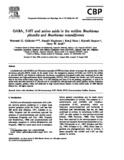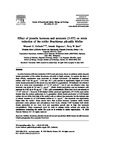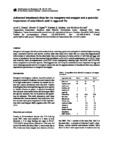| dc.contributor.author | Gallardo, Wenresti G. | |
| dc.contributor.author | Hagiwara, Atsushi | |
| dc.contributor.author | Tomita, Yuichi | |
| dc.contributor.author | Snell, Terry W. | |
| dc.date.accessioned | 2013-11-26T03:50:41Z | |
| dc.date.available | 2013-11-26T03:50:41Z | |
| dc.date.issued | 1999 | |
| dc.identifier.citation | Gallardo, W. G., Hagiwara, A., Tomita, Y., & Snell, T. W. (1999). Effect of growth hormone and γ-aminobutyric acid on Brachionus plicatilis (Rotifera) reproduction at low food or high ammonia levels. Journal of Experimental Marine Biology and Ecology, 240(2), 179-191. | en |
| dc.identifier.issn | 0022-0981 | |
| dc.identifier.uri | http://hdl.handle.net/10862/1761 | |
| dc.description.abstract | Growth hormone (GH, 0.0025 and 0.025 I.U. ml−1) and γ-aminobutyric acid (GABA, 50 μg ml−1) enhance rotifer population growth in batch cultures. In order to further understand the mechanism of their actions, we conducted experiments culturing isolated females at low food and high free ammonia levels. At an optimum food level of 7×106Nannochloropsis oculata cells ml−1 or at low free ammonia level of 2.4 μg ml−1, the F1 offspring of rotifers treated with GH at 0.0025 I.U. ml−1 had significantly higher population growth rate (r) and net reproduction rate (Ro), and shorter generation time than untreated rotifers. At a lower food level of 7×105 cells ml−1 or at high free ammonia level of 3.1 μg ml−1, rotifers treated with GABA at 50 μg ml−1 had significantly higher r and Ro, and shorter generation time. These results indicate that GABA is effective in enhancing rotifer reproduction when rotifers are cultured under stress whereas GH enhances rotifer reproduction when culture conditions are optimal. Significant effects were also observed in F1 and F2 generations which were not treated with hormones. These data may be useful for treating rotifer mass cultures to mitigate the effects of stress caused by high population densities. | en |
| dc.description.sponsorship | This work was partly supported by the Sasakawa Scientific Research Grant (No. 9-383M) from The Japan Science Society to W.G. Gallardo. The Japanese Government is also gratefully acknowledged for the Monbusho scholarship to W.G. Gallardo for his Ph.D. studies. | en |
| dc.language.iso | en | en |
| dc.publisher | Elsevier | en |
| dc.subject | Rotifera | en |
| dc.subject | Brachionus plicatilis | en |
| dc.subject | Food limitation | en |
| dc.subject | Free ammonia | en |
| dc.subject | growth control | en |
| dc.subject | somatotropin | en |
| dc.subject | γ-Aminobutyric acid | en |
| dc.subject | gamma-aminobutyric acid | en |
| dc.subject | rotifers | en |
| dc.subject | Wheel animalcules | en |
| dc.subject | gamma-amino butyric acid | en |
| dc.title | Effect of growth hormone and γ-aminobutyric acid on Brachionus plicatilis (Rotifera) reproduction at low food or high ammonia levels | en |
| dc.type | Article | en |
| dc.citation.volume | 240 | |
| dc.citation.issue | 2 | |
| dc.citation.spage | 179 | |
| dc.citation.epage | 191 | |
| dc.citation.journalTitle | Journal of Experimental Marine Biology and Ecology | en |
| dc.subject.asfa | ammonia | en |
| dc.subject.asfa | batch culture | en |
| dc.subject.asfa | stress | en |
| dc.subject.asfa | food availability | en |
| dc.subject.asfa | hormones | en |
| dc.subject.asfa | population dynamics | en |
| dc.subject.asfa | sexual reproduction | en |
| dc.subject.asfa | reproduction | en |
| dc.identifier.doi | 10.1016/S0022-0981(99)00055-6 | |
| dc.subject.scientificName | Nannochloropsis oculata | en |



